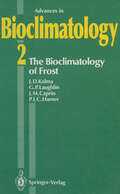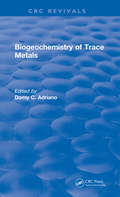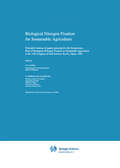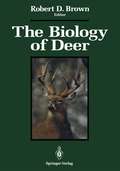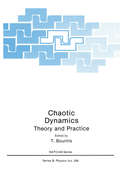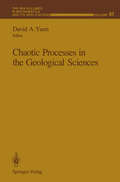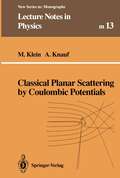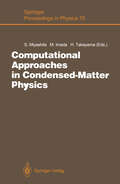- Table View
- List View
Baugeologie: Eine praxisorientierte Anleitung für Bauingenieure und Geowissenschaftler (Springer-Lehrbuch)
by Wolfgang R. DachrothDie Baugeologie ist gedacht für Studenten der Fachrichtung Bauingenieurwesen und der Ingenieurgeologie. Das Lehrbuch ist eine ingenieurtechnische Anleitung mit zahlreichen praktischen Beispielen. Dabei werden die erforderlichen geologischen Untersuchungen und die zu ermittelnden Bodenkenngrößen beschrieben und die Probleme des Grund- und Erdbaus erörtert. Der Benutzer des Buches wird in die Fachsprache, Denkweise und die Berechnungsmethoden der Bauingenieure eingeführt und in die Lage versetzt, selbstständig erdstatische Berechnungen und Abschätzungen wirksamer Kräfte durchzuführen. Folgende Themenkreise werden dabei ausführlich behandelt: Gründung von Bauwerken; Baugruben und Gräben; Stabilisierung von Hängen, Böschungen und Baugrubenwänden; Straßenbau; Tunnelbau; Wasserbau. Den immer drängender werdenden Problemen im Umweltbereich wird durch ein eigenes Kapitel Abfallentsorgung und Deponietechnik Rechnung getragen.
The Bioclimatology of Frost: Its Occurrence, Impact and Protection (Advances in Bioclimatology #2)
by J. D. Kalma G. P. Laughlin J. M. Caprio P.J.C. HamerThe economic costs of frosts in agriculture and horticulture in many parts of the world can be very significant. Reports in the media include accounts on how frosts have devastated coffee crops in Brazil or in Papua New Guinea, and how frosts have seriously damaged the Florida citrus industry. Frost may cause losses in current harvests or a decline in future yields through more permanent damage to trees and bushes. Damaging frosts may occur as infrequent, short-term events with sub-zero temperatures or with unusually severe winter temperatures which extend over long periods. In this book we have aimed at providing a comprehensive review of recent advances in the area of frost research. The stimulus for writing this book has come from the recognition that there is a shortage of recent texts which deal exclusively with the bioclimatology of frost. Bioclimatology deals with the relations between climate and life and the present text is particularly concerned with the effects of low temperatures on plants. Our purpose has been to assist researchers, engineers, extension officers and students in understanding the physical aspects of frost occurrence and frost distribution as well as the biological and phenological aspects of frost damage and to provide an overview of direct and indirect methods of frost pro tection and prevention.
Biogeochemistry of Trace Metals: Advances In Trace Substances Research (CRC Press Revivals)
by Domy C. AdrianoBiogeochemistry of Trace Metals is a compendium of the most recent information available on the effects of trace metals in soil quality and its potential threat on the transfer of these contaminants to consumers. Most of the chapters in the book were presented as papers during the First International Conference on the Biogeochemistry of Trace Elements (formerly Metals in Soils, Plants, Waters, and Animals) held in Orlando, Florida in May, 1990. Topics discussed include background levels of metals in soils and/or plants (covering western Europe; temperate, humid Europe; and the People's Republic of China); metal cycling and transfer in the food chain in agroecosystems; uptake and accumulation of metals by bacteria, fungi, and invertebrates; mechanistic aspects of metals; the microbial aspects of soil selenium losses; and manganese sorption on soil constituents.
Biogeochemistry of Trace Metals: Advances In Trace Substances Research (CRC Press Revivals)
by Domy C. AdrianoBiogeochemistry of Trace Metals is a compendium of the most recent information available on the effects of trace metals in soil quality and its potential threat on the transfer of these contaminants to consumers. Most of the chapters in the book were presented as papers during the First International Conference on the Biogeochemistry of Trace Elements (formerly Metals in Soils, Plants, Waters, and Animals) held in Orlando, Florida in May, 1990. Topics discussed include background levels of metals in soils and/or plants (covering western Europe; temperate, humid Europe; and the People's Republic of China); metal cycling and transfer in the food chain in agroecosystems; uptake and accumulation of metals by bacteria, fungi, and invertebrates; mechanistic aspects of metals; the microbial aspects of soil selenium losses; and manganese sorption on soil constituents.
Biological Nitrogen Fixation for Sustainable Agriculture: Extended versions of papers presented in the Symposium, Role of Biological Nitrogen Fixation in Sustainable Agriculture at the 13th Congress of Soil Science, Kyoto, Japan, 1990 (Developments in Plant and Soil Sciences #49)
by J. K. Ladha T. George C. BohloolChemical fertilizers have had a significant impact on food production in the recent past, and are today an indispensable part of modern agriculture. On the other hand, the oil crisis of the 1970s and the current Middle East problems are constant reminders of the vulnerability of our fossil fuel dependent agriculture. There are vast areas of the developing world where N fertilizers are neither available nor affordable and, in most of these countries, balance of payment problems have resulted in the removal of N fertilizer subsidies. The external costs of environmental degradation and human health far exceed economic concerns. Input efficiency of N fertilizer is one of the lowest and, in turn, contributes substantially to environmental pollution. Nitrate in ground and surface waters and the threat to the stability of the ozone layer from gaseous oxides of nitrogen are major health and environmental concerns. The removal of large quantities of crop produce from the land also depletes soil of its native N reserves. Another concern is the decline in crop yields under continuous use of N fertilizers. These economic, environmental and production considerations dictate that biological alternatives which can augment, and in some cases replace, N fertilizers must be exploited. Long-term sustainability of agricultural systems must rely on the use and effective management of internal resources. The process of biological nitrogen fixation offers and economically attractive and ecologically sound means of reducing external nitrogen input and improving the quality and quantity of internal resources. In this book, we outline sustainability issues that dictate an increased use of biological nitrogen fixation and the constraints on its optimal use in agriculture.
The Biology of Deer
by Robert D. BrownThe first International Conference on the Biology of Deer Production was held at Dunedin, New Zealand in 1983. That meeting provided, for the first time, a forum for those with interests in either wild deer management or farmed deer production to come together. Scientists, wild deer managers, domestic deer farmers, veterinarians, venison and antler product producers, and others were able to discuss common problems and to share their knowledge and experience. The relationships formed at that meeting, and the information amassed in the resulting Proceedings, sparked new endeavors in cervid research, management, and production. A great deal has taken place in the world of deer biology since 1983. Wild deer populations, although ever increasing in many areas of the world, face new hazards of habitat loss, environmental contamination, and overexploitation. Some species are closer to extinction than ever. Game managers often face political as well as biological challenges. Many more deer are now on farms, leading to greater concerns about disease control and increased needs for husbandry information. Researchers have accumulated considerable new in formation, some of it in areas such as biochemical genetics, not discussed in 1983.
Black Hole Physics (Nato Science Series C: #364)
by V. De Sabbata Zhenjiu Zhenjiu ZhangIn these last years Black hole Physics has developed rapidly both from theoretical and observational aspects: especially as regards quantum aspects many things must be clarified as for instance the processes occuring near mini black holes with spontaneous creation of particles that eventually lead to the evaporation of black hole. In these last stages probably a connection with string theory will appears. This field of research was subject of the NATO Adavanced study Institute on "Black Hole Physics" which was held at the Ettore Majorana Center for Scientific Culture in Erice (Sicily, th Italy) from May 12th through May 22 , 1991. It was at the same time the 12th Course of the International School of Cosmology and Gravitation. During this 12th Course, after recalling the starting point that is the concept of black hole in Newton theory, the lectures are gone through classical, quantum, cosmological and astrophysical aspects. Of course in order to understand fully the behaviour of these objects one is faced with a large number of broad areas related to different branches of physics. In fact have been widely treated not only classical aspects, thermodynamics, entropy, internal dynamics, cosmology, inflation and astrophysics but quantum behaviour involving creation of particles, Hawking rad iation, until the modern theory of strings and superstrings that claims the unification of all interactions. So the physics involved and discussed in the various lectures goes from cosmology and very early universe to that of elementary particles including neutrino physics.
BMVC92: Proceedings of the British Machine Vision Conference, organised by the British Machine Vision Association 22–24 September 1992 Leeds
by David Hogg Roger BoyleThis book contains the 61 papers that were accepted for presenta tion at the 1992 British Machine Vision Conference. Together they provide a snapshot of current machine vision research throughout the UK in 24 different institutions. There are also several papers from vision groups in the rest of Europe, North America and Australia. At the start of the book is an invited paper from the first keynote speaker, Robert Haralick. The quality of papers submitted to the conference was very high and the programme committee had a hard task selecting around half for presentation at the meeting and inclusion in these proceedings. It is a positive feature of the annual BMV A conference that the entire process from the submission deadline through to the conference itself and publication of the proceedings is completed in under 5 months. My thanks to members of the programme committee for their essential contribution to the success of the conference and to Roger Boyle, Charlie Brown, Nick Efford and Sue Nemes for their excellent local organisation and administration of the conference at the University of Leeds.
Caledonian Structures in Britain: South of the Midland Valley
by J. E. TreagusThis volume deals with those sites selected as part of the Geological Conservation Review (GCR) within the southern British part of the Caledonides, that is, the paratectonic Caledonides - a Caledonian terrane without strong and pervasive deformation and metamorphism, such as occurred further north. This orogenic belt formed by long and complex processes of earth movements between 500 and 380 million years before the present (?late Cambrian to mid-Devonian times), and has been classic ground for geologists for two hundred years. It is perhaps no accident that James Hutton in 1795 chose to illustrate his geostrophic cycle (and unconformity) with three visually explicit examples of the deformation wrought on Lower Palaeozoic rocks by Caledonian events. The former Caledonian mountain chain, which can be seen today in fragmented pieces in Scandinavia, Britain and Ireland, and North America, was ultimately the result of the collision of two continental plates and the closure of a former ocean, Iapetus. Some of these fragments, including those in Scandinavia, southern Britain, and the Republic of Ireland and the Maritime Provinces of Canada, are thought to have lain on the south side of the ocean before collision: the rest of North America, northern Ireland, and Scotland are thought to have lain north of the former Iapetus.
Catastrophe Theory
by Vladimir I. Arnol'dThe new edition of this non-mathematical review of catastrophe theory contains updated results and many new or expanded topics including delayed loss of stability, shock waves, and interior scattering. Three new sections offer the history of singularity and its applications from da Vinci to today, a discussion of perestroika in terms of the theory of metamorphosis, and a list of 93 problems touching on most of the subject matter in the book.
The Changing Geography of Africa and the Middle East
by Graham P. Chapman Kathleen M. BakerCROSS REF DEV STUDIES Both Africa and the Middle East have sought alternatives to Western models of development. The last twenty-five years have seen political independence for the states of Africa and increased economic dependence on external aid. The Middle East, resource rich and water poor, continues economically robust but politically unstable. In both regions, widespread poverty continues as does the involvement of the West.Clearly illustrated with basic maps of the countries discussed, The Changing Geography of Africa and the Middle East presents a systematic review of twenty-five years of development. The book will prove an invaluable guide to the physical, economic, social and political environments of contemporary Africa and the Middle East.
The Changing Geography of Africa and the Middle East
by Graham ChapmanCROSS REF DEV STUDIES Both Africa and the Middle East have sought alternatives to Western models of development. The last twenty-five years have seen political independence for the states of Africa and increased economic dependence on external aid. The Middle East, resource rich and water poor, continues economically robust but politically unstable. In both regions, widespread poverty continues as does the involvement of the West.Clearly illustrated with basic maps of the countries discussed, The Changing Geography of Africa and the Middle East presents a systematic review of twenty-five years of development. The book will prove an invaluable guide to the physical, economic, social and political environments of contemporary Africa and the Middle East.
The Changing U.S. Auto Industry: A Geographical Analysis
by James M. RubensteinFirst published in 1992. Routledge is an imprint of Taylor & Francis, an informa company.
The Changing U.S. Auto Industry: A Geographical Analysis
by James M. RubensteinFirst published in 1992. Routledge is an imprint of Taylor & Francis, an informa company.
Chaotic Dynamics: Theory and Practice (Nato Science Series B: #298)
by T. BountisMany conferences, meetings, workshops, summer schools and symposia on nonlinear dynamical systems are being organized these days, dealing with a great variety of topics and themes -classical and quantum, theoretical and experimental. Some focus on integrability, or discuss the mathematical foundations of chaos. Others explore the beauty of fractals, or examine endless possibilities of applications to problems of physics, chemistry, biology and other sciences. A new scientific discipline has thus emerged, with its own distinct philosophical viewpoint and an impressive arsenal of new methods and techniques, which may be called Chaotic Dynamics. Perhaps its most outstanding achievement so far has been to shed new light on many long standing issues involving complicated, irregular or "chaotic" nonlinear phenomena. The concepts of randomness, complexity and unpredictability have been critically re-examined and the fundamental importance of scaling, self-similarity and sensitive dependence on parameters and initial conditions has been firmly established. In this NATO ASI, held at the seaside Greek city of Patras, between July 11- 20, 1991, a serious effort was made to bring together scientists representing many of the different aspects of Chaotic Dynamics. Our main aim was to review recent advances, evaluate the current state of the art and identify some of the more promising directions for research in Chaotic Dynamics.
Chaotic Processes in the Geological Sciences (The IMA Volumes in Mathematics and its Applications #41)
This IMA Volume in Mathematics and its Applications CHAOTIC PROCESSES IN THE GEOLOGICAL SCIENCES is based on the proceedings of a workshop which was an integral part of the 1989- 90 IMA program on "Dynamical Systems and their Applications". The workshop was intended to be an arena for scientific exchanges between earth scientists and mathematical researchers, especially with experts in dynamical systems. We thank Shui-Nee Chow, Martin Golubitsky, Richard McGehee, George R. Sell and David Yuen for organizing the meeting. We especially thank David Yuen for editing the proceedings. We also take this opportunity to thank those agencies whose financial support made the workshop possible: the Army Research Office, the Minnesota Supercomputer Institute, the National Science Foundation, and the Office of Naval Research. A vner Friedman Willard Miller, Jr. PREFACE The problems in geological sciences have many nonlinearities from the nature of the complicated physical laws which give rise to strongly chaotic behavior. Foremost and most visible are earthquakes and volcanic eruptions, more subtle are the time dependent variations of the Earth's magnetic fields and motions of the surface plates.
Chaotic Transport in Dynamical Systems (Interdisciplinary Applied Mathematics #2)
by Stephen WigginsProvides a new and more realistic framework for describing the dynamics of non-linear systems. A number of issues arising in applied dynamical systems from the viewpoint of problems of phase space transport are raised in this monograph. Illustrating phase space transport problems arising in a variety of applications that can be modeled as time-periodic perturbations of planar Hamiltonian systems, the book begins with the study of transport in the associated two-dimensional Poincaré Map. This serves as a starting point for the further motivation of the transport issues through the development of ideas in a non-perturbative framework with generalizations to higher dimensions as well as more general time dependence. A timely and important contribution to those concerned with the applications of mathematics.
Chitin Chemistry
by George A.F. RobertsThe book presents a comprehensive and critical account of the chemistry of chitin and chitosan. The first three chapters cover chemical structure and morphology, including that of chitin-protein complexes of native chitin, the isolation of chitin and the preparation of chitosan, and methods of analysis for both polymers. The fourth and largest chapter deals with their derivatisation whilst further aspects of their chemistry such as acid-base properties, metal ion adsorption, degradation, solubility, solution behaviour and gelation, are dealt with in the final two chapters.
The Christopher Columbus Encyclopedia
by Silvio A. BedingThe European discovery of the Americas in 1492 was one of the most important events of the Renaissance, and with it Christopher Columbus changed the course of world history. Now, five hundred years later, this 2-volume reference work will chart new courses in the study and understanding of Columbus and the Age of Discovery. Much more than an account of the man and his voyages, The Christopher Columbus Encyclopedia is a complete A-Z look at the world during this momentous era. In two volumes, The Christopher Columbus Encyclopedia contains more than 350 signed original articles ranging from 250 to more than 10,000 words, written by nearly 150 contributors from around the world. The work includes cross-references, bibliographies for each article, and a comprehensive index. The work is fully illustrated, with hundreds of maps, drawings and photographs.
Classical and Quantum Dynamics: from Classical Paths to Path Integrals
by Walter Dittrich Martin ReuterIn the past 10 to 15 years, the quantum leap in understanding of nonlinear dynamics has radically changed the frame of reference of physicists contemplating such systems. This book treats classical and quantum mechanics using an approach as introduced by nonlinear Hamiltonian dynamics and path integral methods. It is written for graduate students who want to become familiar with the more advancedcomputational strategies in classical and quantum dynamics. Therefore, worked examples comprise a large part of the text. While the first half of the book lays the groundwork for a standard course, the second half, with its detailed treatment of the time-dependent oscillator, classical and quantum Chern-Simons mechanics, the Maslov anomaly and the Berry phase, willacquaint the reader with modern topological methods that have not as yet found their way into the textbook literature.
Classical Planar Scattering by Coulombic Potentials (Lecture Notes in Physics Monographs #13)
by Markus Klein Andreas KnaufAstronomy as well as molecular physics describe non-relativistic motion by an interaction of the same form: By Newton's respectively by Coulomb's potential. But whereas the fundamental laws of motion thus have a simple form, the n-body problem withstood (for n > 2) all attempts of an explicit solution. Indeed, the studies of Poincare at the end of the last century lead to the conclusion that such an explicit solution should be impossible. Poincare himselfopened a new epoch for rational mechanics by asking qual itative questions like the one about the stability of the solar system. To a largeextent, his work, which was critical for the formation of differential geometry and topology, was motivated by problems arising in the analysis of the n-body problem ([38], p. 183). As it turned out, even by confining oneselfto questions ofqualitativenature, the general n-body problem could not be solved. Rather, simplified models were treated, like planar motion or the restricted 3-body problem, where the motion of a test particle did not influence the other two bodies.
Clifford Algebra and Spinor-Valued Functions: A Function Theory for the Dirac Operator (Mathematics and Its Applications #53)
by R. Delanghe F. Sommen V. SoucekComputational Approaches in Condensed-Matter Physics: Proceedings of the 6th Nishinomiya-Yukawa Memorial Symposium, Nishinomiya, Japan, October 24 and 25, 1991 (Springer Proceedings in Physics #70)
by Seiji Miyashita Masatoshi Imada Hajime TakayamaInteracting many-body systems are the main subjects of research in theoretical condensed matter physics, and they are the source of both the interest and the difficulty in this field. In order to understand the macroscopic properties of matter in terms of macroscopic knowledge, many analytic and approximate methods have been introduced. The contributions to this proceedings volume focus on the most recent developments of computational approaches in condensed matter physics. Monte Carlo methods and molecular dynamics simulations applied to strongly correlated classical and quantum systems such as electron systems, quantum spin systems, spin glassss, coupled map systems, polymers and other random and comlex systems are reviewed. Comprising easy to follow introductions to each field covered and also more specialized contributions,this proceedings volume explains why computational approaches are necessary and how different fields are related to each other.
Computational Fluid Dynamics: An Introduction
by J. D. Anderson G. Degrez E. Dick R. GrundmannThis book is an outgrowth of a von Kannan Institute Lecture Series by the same title first presented in 1985 and repeated with modifications in succeeding years. The objective, then and now, was to present the subject of computational fluid dynamics (CFD) to an audience unfamiliar with all but the most basic aspects of numerical techniques and to do so in such a way that the practical application ofCFD would become clear to everyone. Remarks from hundreds of persons who followed this course encouraged the editor and the authors to improve the content and organization year by year and eventually to produce the present volume. The book is divided into two parts. In the first part, John Anderson lays out the subject by first describing the governing equations offluid dynamics, concentration on their mathematical properties which contain the keys to the choice of the numerical approach. Methods of discretizing the equations are discussed next and then transformation techniques and grids are also discussed. This section closes with two examples of numerical methods which can be understood easily by all concerned: source and vortex panel methods and the explicit method. The second part of the book is devoted to four self-contained chapters on more advanced material: Roger Grundmann treats the boundary layer equations and methods of solution; Gerard Degrez treats implicit time-marching methods for inviscid and viscous compressible flows, and Eric Dick treats, in two separate articles, both finite-volume and finite-element methods.

